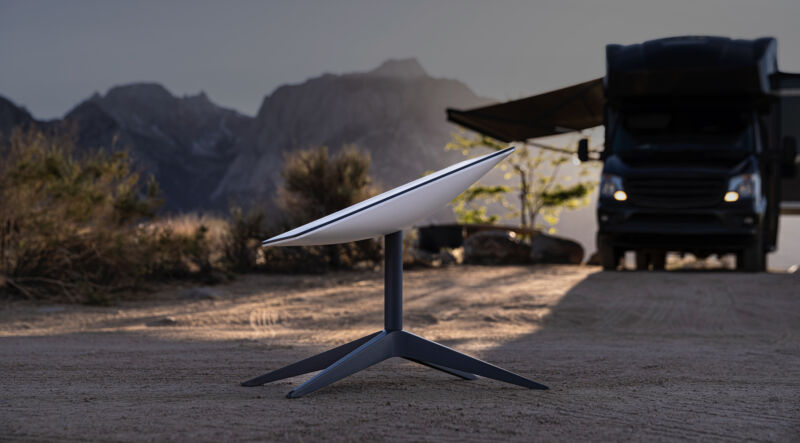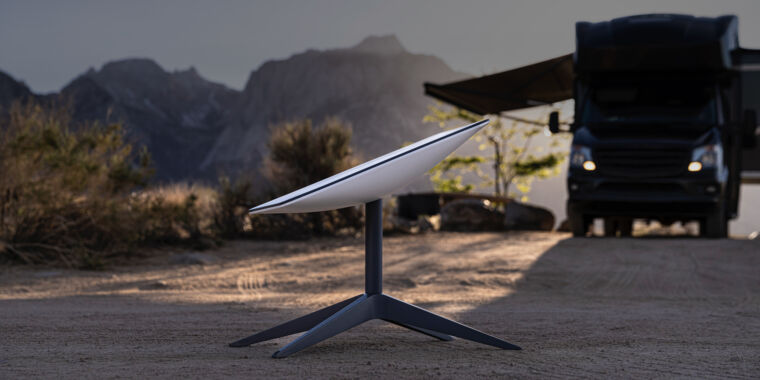FCC allows Starlink to offer Internet service on moving vehicles in the United States
 Enlarge / A Starlink satellite dish.
Stellar Link
Enlarge / A Starlink satellite dish.
Stellar Link
SpaceX has won US approval to provide Starlink satellite internet service on moving vehicles, ships and planes. In an order released Thursday, the Federal Communications Commission granted SpaceX's request to operate Enterprise and Consumer in Motion (ESIM) Earth Stations across the United States.
The FCC has also approved an application by Kepler Communications to operate ESIMs on ships. Starlink and Kepler will be authorized to provide services on ships in US territorial waters and international waters.
Starlink offers a service for RVs, but says it's not designed for use while vehicles are in motion. A version to move recreational vehicles will likely be offered at some point, now that SpaceX has received FCC approval, which states that "SpaceX is permitted to operate moving ground stations on vehicles across the United States ". SpaceX also plans to provide Starlink Internet on flights.
The order issued by the FCC's International Bureau states that granting the applications "will serve the public interest by allowing SpaceX and Kepler to offer expanded broadband capabilities and serve unserved and underserved areas." served".
SpaceX has applied to the FCC for permission to offer Starlink broadband on moving vehicles, ships and aircraft in March 2021. SpaceX says it will use rugged Starlink antennas that can withstand "harsh environments" with extreme levels of heat and cold. The terminals are too big for passenger cars and are for planes, ships, large trucks and RVs, SpaceX CEO Elon Musk said last year.
FCC approves license despite Dish's objectionThe frequency bands used for space-to-Earth transmissions with ESIM range from 10.7 GHz to 12.7 GHz. The FCC is separately considering licensing mobile services in the 12.2-12.7 GHz band. Dish Network wants to use this band for its cellular network, but SpaceX argues that 12 GHz mobile service would make Starlink unusable for most Americans because the satellite Internet network uses the same spectrum for downloads.
The FCC order noted that Dish and RS Access opposed the SpaceX and Kepler ESIM applications, arguing that approval "would effectively constrain the Commission's decision-making in the ongoing regulatory proceeding on the 12 GHz" and "would complement the Commission's ability to reallocate spectrum for land mobile use." But the FCC said its approval is designed so as not to limit options for the 12 GHz procedure:
These services, never before available, promise to extend reach to remote and rural areas and facilitate higher quality broadband services in the air, on the road and on the water. We recognize, however, that the introduction of a potentially large number of additional end users could affect the 12 GHz spectrum environment. We are therefore imposing conditions to ensure that the granting of this request will not materially affect the outcome of the 12 GHz rulemaking process.
SpaceX must accept interference in the 12 GHz bandThe FCC said the clearances are "on an unprotected, i.e., unprotected, basis with respect to operations in the 12.2-12.7 GHz band. Accordingly, applicants' ESIM operations must accept any interference received from both current and future licensed services in the band - even if such interference causes undesired operations - and must not cause harmful interference to any licensed service, whether he is licensed or not."
The FCC has required Starlink and Kepler to "disclose to their customers that their ESIM service is provided under these terms so that their customers understand that there is no expectation of protection from interference. SpaceX and Kepler must disclose the unprotected status of their ES...

 Enlarge / A Starlink satellite dish.
Stellar Link
Enlarge / A Starlink satellite dish.
Stellar Link
SpaceX has won US approval to provide Starlink satellite internet service on moving vehicles, ships and planes. In an order released Thursday, the Federal Communications Commission granted SpaceX's request to operate Enterprise and Consumer in Motion (ESIM) Earth Stations across the United States.
The FCC has also approved an application by Kepler Communications to operate ESIMs on ships. Starlink and Kepler will be authorized to provide services on ships in US territorial waters and international waters.
Starlink offers a service for RVs, but says it's not designed for use while vehicles are in motion. A version to move recreational vehicles will likely be offered at some point, now that SpaceX has received FCC approval, which states that "SpaceX is permitted to operate moving ground stations on vehicles across the United States ". SpaceX also plans to provide Starlink Internet on flights.
The order issued by the FCC's International Bureau states that granting the applications "will serve the public interest by allowing SpaceX and Kepler to offer expanded broadband capabilities and serve unserved and underserved areas." served".
SpaceX has applied to the FCC for permission to offer Starlink broadband on moving vehicles, ships and aircraft in March 2021. SpaceX says it will use rugged Starlink antennas that can withstand "harsh environments" with extreme levels of heat and cold. The terminals are too big for passenger cars and are for planes, ships, large trucks and RVs, SpaceX CEO Elon Musk said last year.
FCC approves license despite Dish's objectionThe frequency bands used for space-to-Earth transmissions with ESIM range from 10.7 GHz to 12.7 GHz. The FCC is separately considering licensing mobile services in the 12.2-12.7 GHz band. Dish Network wants to use this band for its cellular network, but SpaceX argues that 12 GHz mobile service would make Starlink unusable for most Americans because the satellite Internet network uses the same spectrum for downloads.
The FCC order noted that Dish and RS Access opposed the SpaceX and Kepler ESIM applications, arguing that approval "would effectively constrain the Commission's decision-making in the ongoing regulatory proceeding on the 12 GHz" and "would complement the Commission's ability to reallocate spectrum for land mobile use." But the FCC said its approval is designed so as not to limit options for the 12 GHz procedure:
These services, never before available, promise to extend reach to remote and rural areas and facilitate higher quality broadband services in the air, on the road and on the water. We recognize, however, that the introduction of a potentially large number of additional end users could affect the 12 GHz spectrum environment. We are therefore imposing conditions to ensure that the granting of this request will not materially affect the outcome of the 12 GHz rulemaking process.
SpaceX must accept interference in the 12 GHz bandThe FCC said the clearances are "on an unprotected, i.e., unprotected, basis with respect to operations in the 12.2-12.7 GHz band. Accordingly, applicants' ESIM operations must accept any interference received from both current and future licensed services in the band - even if such interference causes undesired operations - and must not cause harmful interference to any licensed service, whether he is licensed or not."
The FCC has required Starlink and Kepler to "disclose to their customers that their ESIM service is provided under these terms so that their customers understand that there is no expectation of protection from interference. SpaceX and Kepler must disclose the unprotected status of their ES...
What's Your Reaction?






















